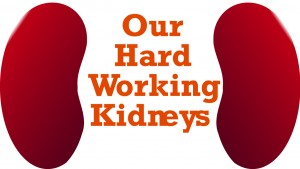
Please consult your doctor or regular health physician before following suggestions found in any Sun Day health columns/stories.
As mentioned in past articles on this topic, prevention is always the goal with kidney failure. Lifelong diligence is important in keeping blood sugar and blood pressure under control.
Once kidney failure is present, the goal is to prevent further deterioration. If ignored, the kidney will progress to complete failure, but if addressed and treated aggressively, kidney function can be preserved, though not always improved.
Specific treatments, many of which have become available in recent years, are dependent upon the underlying diseases that can occur to our hard working kidneys. For instance, though kidney cancer does not appear to respond well to chemotherapy or radiation, kidney stones can now be effectively treated by changing a diet too high in protein, salt, and sugar consumption diet for starters, passing stones through the urethra or shock-wave treatment, or through surgery.
Gout, caused by under excretion of uric acid from the kidneys, also often responds to diet changes. Excessive intake of liquid, known as water toxicity, leading to gross overuse of the kidneys and dehydration leading to gross underuse of liquid for the kidneys (and possible brain damage where the brain stops working) are easily controlled through liquid diet alterations, as is an electrolyte imbalance.
Since kidneys cannot easily remove excess water, salt, or potassium from the body, the following foods need to be consumed in limited amounts: bananas, apricots, salt, and salt substitutes. Renal failure may have too much phosphorous associated with calcium metabolism that can take calcium from the bones, possibly leading to osteoporosis. Seniors with this condition are recommended to watch out for overuse of milk, cheese, nuts, and cola drinks.
A simple kidney cyst which shows growth through periodic physician monitoring often responds well to aspiration or removal of the liquid in the singular cyst.
According to healthinaging.org, “Quick treatment of the cause of your acute kidney failure is often enough to restore kidney function.” The web page adds that dialysis treatments may be needed to avoid complications until kidneys recover. Though we are not discussing bladder issues at this time, it is crucial to mention that a health provider be called immediately for any signs of a urinary tract infection, including fever, tiredness, low back pain, and any blood in the urine, as well as trouble urinating.
People with kidney disease don’t usually know they have it. Blood and urine tests are commonly used for crucial early detection. Blood tests used for diagnosis include the following:
1. Creatinine and blood urea nitrogen tests which indicate how well the organs are clearing toxins from the blood. Creatinine is the medical name for the muscle’s waste product released into the blood.
2. The blood albumin test shows how well you are eating through a type of protein found in the blood.
3. Glomerular filtration rate tests your kidneys for filtering strength.
Urine tests include:
1. The albumin urine test, which indicates albumin, a protein, that passes into the kidneys when they are damaged.
2. Testing for electrolytes showing whether kidneys are appropriately monitoring and filtering blood. Other testing done for diagnosis here are ultrasound tests and cystoscopy tests (used for studying the urethra and bladder), as in diagnosis of hematuria or blood in the urine.
If all else fails, dialysis and kidney transplants are available for end-stage renal failure. In the United States today, 400,000 people rely on kidney dialysis, while 170,000 live with a kidney transplant. In 1943, a young Dutch physician invented the first successful dialysis machine.
According to Healthinaging.org, there are two types of dialysis procedures. The first, hemodyalsis, includes dialysis treatments taking place about three times weekly, a few hours each time, in a chair at a dialysis center where the patient’s blood is siphoned into a machine, cleansed of waste products, and returned to the body.
The second, ambulatory peritoneal dialysis, occurs through an abdominal tube which operates to cleanse the blood of impurities and return the blood clean to the abdomen. This procedure is done at home while the person is able to walk around. Dialysis patients may live many years with these two treatments.
Kidneys have lent themselves well to the organ transplant surgery idea since the body can live well with only one kidney. Indeed, in 1954 in a Boston hospital, the first successful transplant of a major organ took place with the donation of a healthy kidney by one identical twin to his identical twin brother (who was dying of kidney disease).
Sun City resident Ginny McCann remembers how in 1964, her cousin, at the age of 13 underwent successful surgery in the pioneering days of kidney transplants.
“That was about 50 years ago as she is now retired and doing well,” McCann said of her cousin. “She went on dialysis until a suitable donor was found. She was lucky as she had four sisters and one of them was an excellent match.”
Though kidney transplants have become more routine, there are still problems with risk of injuring the ureters and the risk of bleeding and infection, but better anti-rejection meds are now used.
What about research? Because of the slowness in kidney problems developing, it has been difficult to test medicines to help the organ’s many diseases. However, there are major dialysis breakthroughs being developed in labs today around the world.
One is the European Union funded wearable 24/7 artificial kidney device, now being tested on animals, and a possible future replacement or addition for current means of dialysis. To aid in this research is the nanofiber mesh for purifying blood.
Also in this same avenue of research, is the cultured kidney cell layer to improve dialysis. Developed in the Netherlands, these grown-in-the lab cells maintain their functional properties and are able to purify blood. For more info, please check with the National Kidney and Urologic Diseases Information Clearinghouse.




